Yamaha RX-V6A Reviewed at $599.00
Product Name: Yamaha RX-V6A
Product Description: 7.2 CH 8K AV Receiver
-
Design - 9.2/10
9.2/10
-
Audio Quality - 9.2/10
9.2/10
-
Inputs / Ports - 9.2/10
9.2/10
-
OS, Apps and Features - 9/10
9/10
-
Price / Quality - 9/10
9/10
Summary
Reviewed at $599.00
Pros
- Great Dolby Atmos performance
- Nice new design
- Three HDMI 2.1 ports
- Plenty of extra features
Cons
- HDMI 2.1 has problems with certain 4K/120Hz signals
- Less legacy ports than last year
- Front display a bit hard to read
- Cheap looking remote
Cheapest Places to Buy :
*We are a reader-supported website. When you buy through links on our site, we may earn a small affiliate commission at no extra cost to you. Home Media Entertainment does not accept money for reviews.*
Yamaha is a well respected brand in the home theater segment. From their AV receivers and soundbars to their amplifiers and headphones for many years they have managed to be at the top of their game and create a very dedicated fan base with their products. With the arrival of HDMI 2.1 in 2020 in AV receivers it seems that Yamaha not only went ahead and started releasing a new set of models but also decided to go the extra mile and give us a completely new design that would feel more up-to-date in 2021. So in our Yamaha RX-V6A review today we will be looking at the top tier release of their more budget friendly RX-V series.
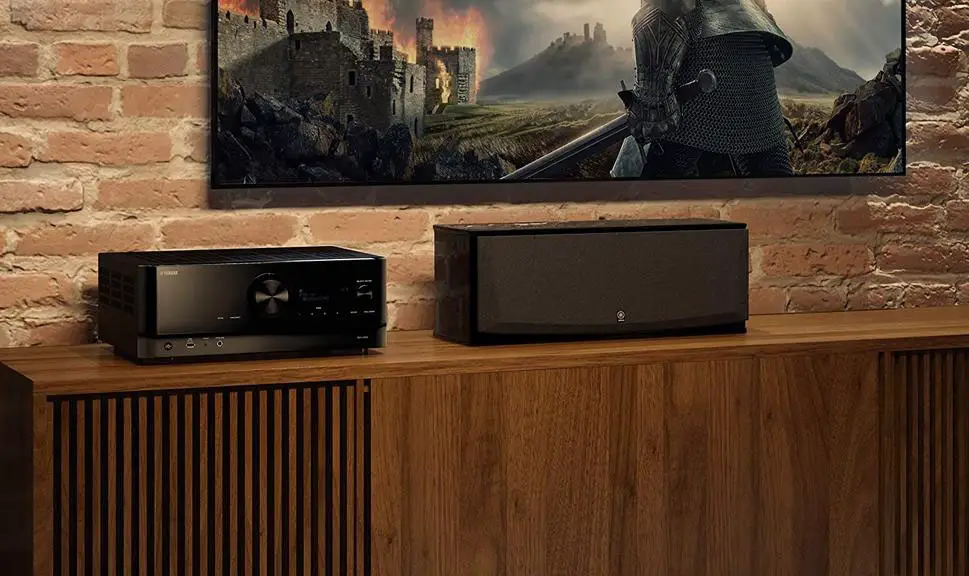
Recently we had the pleasure of reviewing another of their new redesigned releases, the Yamaha RX-V4A, and to be honest it gave us exactly what you would expect from a Yamaha product. So now that we take one step higher in the performance ladder we were really excited to see what this one would give us. As we had said before, with Yamaha changing the naming of their new releases it is not easy to make a direct connection of the new models to the ones last year. The RX-V4A for example seemed to replace the RX-V485 while the RX-V6A we have here today feels more of a replacement of the RX-V685 but not entirely.
The new unit is a 7.2 channels AV receiver with 100 watts of built-in amplification and supports all the latest features you would expect from an AV receiver of this price. As such we get Dolby Atmos and DTS:X, Dolby Surround and DTS Neural:X up-mixing technologies along with Yamaha’s proprietary virtual tech. There is also yamaha’s YPAO R.S.C. with Multipoint auto calibration system, High Resolution Audio, USB and Bluetooth streaming, MusicCast and Airplay 2 for online and multi-room audio, wireless rear speakers support, Music Enhancer, voice control and obviously the new HDMI 2.1 port with all its game eccentric features like ALLM, VRR, QMS and QFT.
But what sets the RX-V6A apart from the competition, as well as all the new Yamaha receivers this year is that it’s the only company with multiple HDMI 2.1 ports. While everyone else only offer one the RX-V6A features three of them with four more of the older HDMI 2.0 type. But is this enough to make the RX-V6A a unit worth considering? Keep reading to find out.
Design
It seems that in terms of design the RX-V6A is like for like with the RX-V4A we had reviewed recently. You will be hard to make them apart as other than the naming on the lower right corner there is no difference between the two…until you try to lift them for that matter. The RX-V6A measures the exact same 17-1/8” x 14-7/8” x 9-5/8” (435 x 377 x 245 mm) but this time weights 21.6 lbs (9.8 kg) as it has bigger amplifiers than its smaller brother. Height can obviously be lowered to just 6-3/4” (171 mm) by placing the antennas in a horizontal position and will gain you some extra breathing space.
Now as for its design we definitely like what Yamaha came up with for their new releases. Its look is certainly more modern and goes away from the old style that looked outdated in 2021. This part of our review is exactly the same as in the RX-V4A as there are no differences here at all. We will be making of course any changes or additions for the RX-V6A wherever we deem necessary.
Featuring an almost entirely front gloss side with rounded corners the volume knob has been repositioned in the middle and the display screen got updated as we get an LCD variant that is placed on the right side of the volume knob. On the far right a second smaller knob is used for navigating the display screen and selecting input sources.
On the left of the central knob we find two small indicators for Zone and Pure Direct while on its right side, under the LCD display, there are some touch controls with four SCENE buttons, Return and Menu.

On the lower part of the front face there is a small part that features a matte surface and this is where we find a circular button on the far left for power along with a single USB port for connecting external storage, the YPAO microphone input port and the usual Headphones jack. All these redesigned AV receivers seem to have lost the front analogue stereo input. We saw this in the RX-V4A and it seems the same happened here also.
The RX-V6A comes with a high slew rate amplifier which contributes a precise signal transmission, especially suitable for high resolution audio signal. Generally high slew rate amplifiers causes unstable signal transmission but Yamaha’s newly design circuit achieves high slew rate with stable signal transmission. The receiver also features 384 kHz / 32-bit BB PCM5102A DAC for all its audio conversions.
Let’s take a look at the supplied remote now. The remote is exactly the same as the one we had seen during our RX-V4A testing and to be honest this comes as no surprise to us. The remote is the usual plastic with rubber buttons remote which is by large uninspiring but obviously we shouldn’t complain about it in this price range.
The button placement is exactly the same and only the switch at the top has different naming as it now indicates MAIN and Zone 2 instead. Everything else is exactly the same and it will take you a while to get used of the buttons placement as happens with any new remote but other than that its practicality and functionality is pretty standard. Obviously there is no backlight function which is not so surprising and it becomes harder to use it in the dark.

We definitely like the new design that Yamaha came up with for their latest releases. It looks and feels fresh and if there is one thing they could really improve is the remote as it doesn’t fit with the rest of the design.
Audio Quality
The unit is the typical 7.2 channels receiver we expect to find at this price point. It can support either a 7.2 channels audio setup or if you want to go the Dolby Atmos route it can support up to 5.2.2 channels. As usual we get support for both Dolby Atmos and DTS:X, and obviously all the older audio mixes like Dolby TrueHD, DTS-HD Master Audio, Dolby Digital Plus, Dolby Digital and DTS.
Up-mixing technologies couldn’t be missing from this one so we do get the usual Dolby Surround and DTS Neural:X that are the standards for those receivers and can up-convert legacy tracks like stereo mixes into full surround audio.
In this unit, as with most mid-range releases, we get Yamaha’s Cinema DSP 3D which is exactly the same version we also found in the RX-V4A as well as many of Yamaha’s lower and mid-tier offerings and is a step down from the HD3 version we got in the RX-A1080 and above. Cinema DSP 3D is the technology responsible for creating natural stereoscopic sound fields like movie theaters or concert halls and there is a total of 17 different DSP programs you can choose from in the RX-V6A. In simple terms this tech will process whatever audio signal it receives and in a way enhance it depending on your selection.
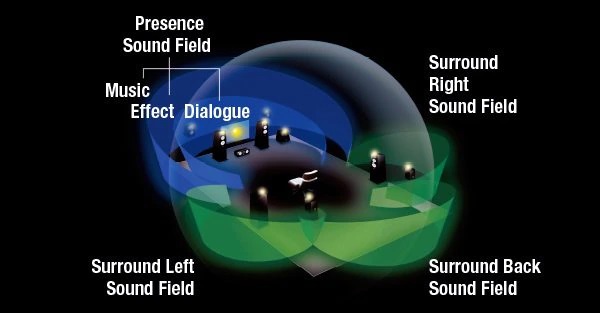
This kind of tech can create some cool effects but as we always like to say the result really depends on the source material and most of the time the end result is very different from the creator’s intentions while the sound comes out very artificial and over-processed. As audio purists we prefer to avoid as much processing as possible but you may find it to your liking so it’s always good to try it out first.
But Cinema DSP 3D is not only capable of simulating various audio environments but is also responsible for the unit’s virtual features. First of all with Virtual Cinema DSP the unit can reproduce surround sound with only the front speakers connected. We also find Virtual Cinema Front and this is a smart feature that lets you place the surround speakers at the front and still get surround activity behind your listening position which can be very handy if you cannot place your surround speakers at the back.
Virtual Surround Back Speaker can create surround activity without the use of surround speakers at all while with Silent Cinema you can enjoy surround and sound field effects by using only your headphones.
When it comes to its internal amplifiers the unit can output 100 watts per channel (8 ohm, 20 Hz – 20 kHz, 0.06% 2ch drive) which obviously goes much lower when used in a full 5.2.2 or even 7.2 channels system.
Moving on to our movie tests we opted for a 5.1.2 channels system with a single subwoofer and two heights speakers that were positioned at the front, above the main speakers. As for the movie we went for, we decided to test something new this time and what better option that the freshly released Godzilla vs Kong with its explosive Dolby Atmos track that was delivered through the included Dolby Digital Plus codec.

The film may not be much in terms of overall quality in our opinion but when it comes to its technical merits there is no doubt of its gargantuan scale. A film like this screams for a surround system that can portray the full size of its grand pieces and be able to render these monsters in all their glory, size and weight. The Yamaha did an excellent job at that and really the front sound stage expanded in front of us in all axis as the camera was trying to capture their true colossal figures.
Obviously the highlight in the film is when these monsters duke it out but through all this all out cacophony the RX-V6A was able to pull it through with tight control and without neglecting the rest of the frequency spectrum in favor of its low end mayhem. Dialogue was nicely contained at the center while both front channels were complementing each other nicely no matter what was on screen.
Surround activity obviously was very much active here with ballistics travelling all around, missiles and fighter jets passing right next to our heads and panning effects giving this necessary extension towards the back that was needed in order to put us right into the middle of the action. When Kong is being transferred by sea and Godzilla attacks there was an abundance of effects at the back both underwater and above the surface that really pulled us into the action.
Equally impressive were the Atmos effects even though they were not as much to the face or as evident as the surrounds were. Many times the camera is positioned on the ground and in order to give vertical extension to the scene the heights speakers did an amazing job with scale and vertical expansion. It was subtle but just what was needed to make the scene more believable and realistic.

But if there is one aspect that really will make you hold onto your seat is the amount of low end prowess and energy you will get from the sequences and neither the Yamaha or our subwoofer were complaining. With each hit, with each punch we were shaking on our seats as if Kong and Godzilla were just outside our room solving their differences. But it was not only how much low end volume was being output. Its resolution and low end clarity was remarkable as even during the most intense scenes it never felt to distort or loose any of its control.
The RX-V6A could really go high on the volume scale and we never managed to reach its limit so you should not worry with that. And if the receiver’s top volume is impressive enough, what was equally impressive was the fact that it did that without much distortion over its output elements. Yes, the RX-V6A may not be for the big rooms but for any medium sized living room or home theater it will do more than fine.
As for music the receiver supports not only the usual lower quality audio formats like MP3, WMA and AAC which by the way all of them can go up to 320 kbps but can also playback High Resolution Audio in the likes of FLAC (384/24 bit), ALAC (96/24 bit) and WAV/AIFF (384/32 bit) files. DSD streaming is also available for up to 11.2 MHz. It seems that Yamaha has updated the specs in the RX-V6A as previous models could support FLAC and WAV files only up to 192kHz.
The receiver also features Yamaha’s Compressed Music Enhancer that is capable of enhancing lower quality audio like MP3 files to near High Resolution Audio quality levels. Compressed Music Enhancer can also work through Bluetooth which usually lowers the audio quality to meet the necessary transmission requirements. This is a feature we have seen in almost all their releases and although you shouldn’t expect a day an night difference in certain cases it can really help with lower quality content.
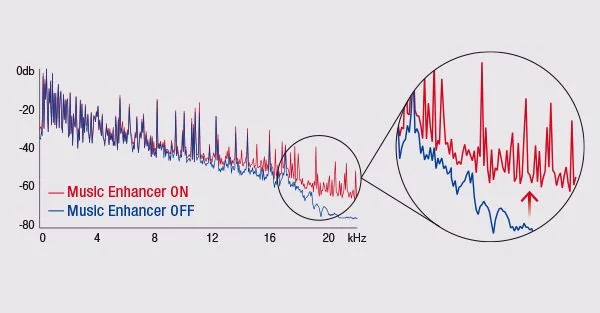
For this testing, as we usually do, we selected a few favorite tracks in FLAC format that we streamed through the front USB port for the best quality possible. All Yamaha receivers are top performers when it comes to music and the RX-V6A once again proved us why Yamaha is so much favored by so many home theater fans.
The music stage in front of us filled with energy and life as the Yamaha really pushed the front channels to their limits. Sound imaging was great with good accuracy and impressive resolution making it very easy to pinpoint the sound sources and the musical instruments in space. Panning sounds were very nice and as impressive as ever.
We didn’t sense that the receiver missed its mark at any point as most of the frequencies were reproduced nicely and with good accuracy. The mid-range had a nice output to it which felt balanced, warm and totally controlled while the high end was full of emotions without becoming to much exciting. The bass had good volume, good energy and enough power. It never felt overwhelming or became boomy even during more demanding low end sessions.
We went ahead and tried various content that ranged from rock, pop, jazz and classical music all the way to heavy metal, electronic and techno music and although there were some genres that the receiver felt more comfortable with than others the general consensus was that it was a pretty good handler for most of them. If you want a receiver for your movies entertainment but also want it to be equally capable handling music then this is definitely the one.
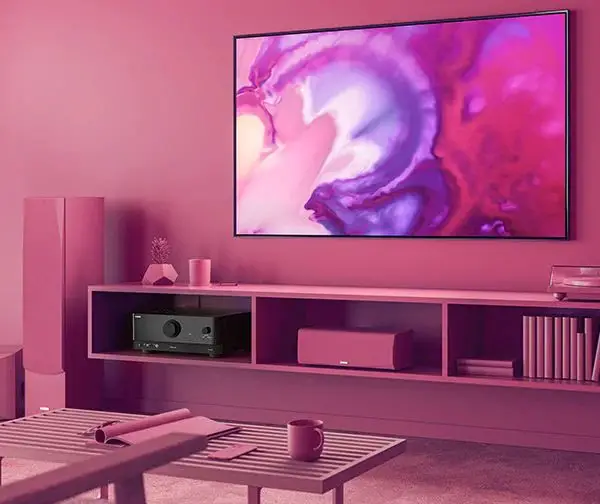
The RX-V6A really proved to us why Yamaha is so stellar with their releases. This may be a mid-range offering but still managed to portray all the values and qualities that Yamaha is known for in their products. And this receiver continues this trend forward.
Ports and Connectivity
As we said above the RX-V6A has some similarities with the RX-V685 but not entirely. And when you look at the connections being offered we see that Yamaha has completely changed their ports layout and numbers and there is a preference towards the HDMI ports instead of all other legacy connections which doesn’t find us entirely against.
At the front we already mentioned that we get a headphones jack, the YPAO microphone port and a single USB for connecting external storage. What is missing here is the analogue stereo input that the RX-V685 had and although this is a small omission we are already one port minus.
As we turn the unit around we find the usual speaker terminals along with seven HDMI inputs at the top. The impressive thing with these new Yamaha receivers is that they offer more HDMI 2.1 inputs than all competing brands in 2020. While Denon and Marantz only have one HDMI 2.1 the Yamaha RX-V6A has three of them which is shocking to say the least for this price! There is also four HDMI 2.0 inputs and a single HDMI output. All these moderate cost releases come with a single output so no surprise here.
The HDMI 2.1 ports in the Yamaha unit bring a huge list of features with them including 4K UltraHD Video (include 4K/60, 50Hz 10/12bit), 3D Video, ARC (Audio Return Channel), eARC (enhanced Audio Return Channel), HDMI Control (CEC), Auto Lip Sync, Deep Color, “x.v.Color”, HD audio playback, 21:9 Aspect Ratio, BT.2020 Colorimetry, HDR Compatible, Dolby Vision, Hybrid Log-Gamma, HDR10+, ALLM, VRR, QMS and QFT.
Now there is another thing we need to mention here about the HDMI 2.1 ports being used in all AV receivers that came out in 2020 including the RX-V6A. We have already mentioned this in all our previous reviews so we will just repeat what we wrote before. It seems that the Panasonic chip that handles the HDMI 2.1 connection cannot process the signal of specific sources that output at 4K/120Hz RGB signal (8-bit, 10-bit, 12-bit) like the Xbox Series X and this results in a black screen. Now there are not many sources that currently support 4K@120Hz with this exact configuration but this is a hardware issue and cannot be solved by a simple firmware update.
Now if you are wondering, the RX-V6A has no problem whatsoever if you are watching movies or playing games at 4K/60Hz and 4K/120Hz YCbCr 4:2:2 signals (32Gbps) or anything below that so in most cases you are going to be absolutely fine. This means that the PS5 works without any problems. In the rare case where the receiver accepts a 4K/120Hz RGB signal (8-bit, 10-bit, 12-bit), like from the Xbox Series X for example, this is when this problem will appear and the only current workaround is to connect your source device directly to your TV and from the eARC connection to the receiver.
To be honest this is a problem that should not happen in the first place and shows that somewhere there has been a major miscommunication between manufacturers but you should keep in mind that this will probably not affect you as much as you may think of.
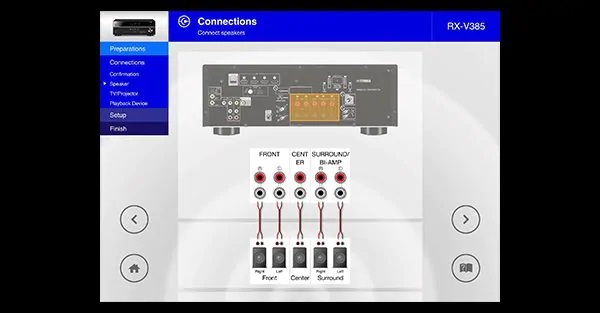
Right now this problem seems to affect all new AV receivers in 2020 including Denon, Marantz and Yamaha. All manufacturers have acknowledged the problem but as far as a solution it seems that it’s a problem that can only be solved with updated hardware and to see full HDMI 2.1 support without any problems we will have to wait for their 2021 releases. If they had the time to update the necessary hardware of course which remains to be seen.
As for the rest of the ports we get, there are 3 analog stereo inputs with another one dedicated to phono, 1 coaxial and 1 optical digital input, 2.2 channels pre-outs, a Zone 2 output, a 12V trigger output, an Ethernet port for wired connection to a local network and the usual DAB/FM and WiFi/Bluetooth antenna connectors.
The receiver comes with built-in WiFi that supports both 2.4 and 5 GHz networks while it also comes with Bluetooth v4.2. This is the same as previously so no changes here.
Overall the RX-V6A features more HDMI ports and less legacy ones. Which is not all that bad. HDMI has become the prevalent connection many years now so phasing out the legacy connections is a natural thing to do. We do get a few still for those with older equipment but the addition of three HDMI 2.1 and another four HDMI 2.0 should be enough for most setups.

OS, Apps and Features
When it comes to extra features the RX-V6A is very similar to the RX-V4A but we find some small additions and certain improvements in the features offered so we will point the differences and changes wherever needed. And as always the first thing we look into is the audio calibration system. Yamaha is using the YPAO (Yamaha Parametric room Acoustic Optimizer) system and as with all these systems it can be scaled according to the model. In the RX-V6A we get the more upgraded version compared to the basic one in the RX-V4A which is called YPAO R.S.C. with Multipoint.
YPAO analyzes your room acoustics, measures speaker characteristics and adjusts unwanted reflected sounds to optimize every channel of your home theater. In addition the R.S.C. (Reflected Sound Control) feature is responsible of correcting early reflections and provides DSP Effect Normalisation through the Cinema DSP parameters according to these reflected sounds. This results in a more balanced outcome compared to the basic system and it can improve Dolby Atmos and DTS:X performance.
The whole process is relatively easy to finish and by following the on screen directions you can finish it without any trouble even if you don’t have much experience with similar calibrations before. Even if there is some problem to your setup the YPAO system will make sure to warn you with some message. In general these calibration systems offer pretty good settings and especially for those that are not used to make manual tuning it can be an excellent helper.

But before you even make this sound calibration you need to follow the initial setup in order to connect everything to the receiver. Things are pretty simple here if you have done some basic connections before and you shouldn’t have any trouble finishing this part very fast. But even if you have any troubles Yamaha has created the Yamaha AV Receiver Setup Guide App which is a dedicated setup app that you can install to your mobile device, choose the appropriate AV receiver and follow the instructions to make the necessary wire connections.
This app if free to download and is available for both iOS and Android devices and provide you with very simple visual information on how to connect everything for your specific system. A nice small app and although not many are going to use it, if you are are totally new to all this then you will certainly find this one very handy.
The built-in menus and user interface is nothing spectacular to talk about. They are simple, nicely organized and positioned to the left of the image with simple graphics overlaying over the image input. We would expect at some point to get an updated visual interface with nice graphics as we see in smart TVs nowadays but it seems that manufacturers are reluctant to go that route yet.
A common feature most receivers have nowadays, including the RX-V6A is ECO mode that you can enable and let the receiver manage its power output in order to achieve power economy. But if you want the unit to perform at its peak power at all times then we suggest you to better leave this setting turned off. We would only recommend this if your unit becomes really hot due to being in a closed environment and you have no other way of cooling it down, then this could potentially help a little. But for that there are additional cooling solutions to consider also.
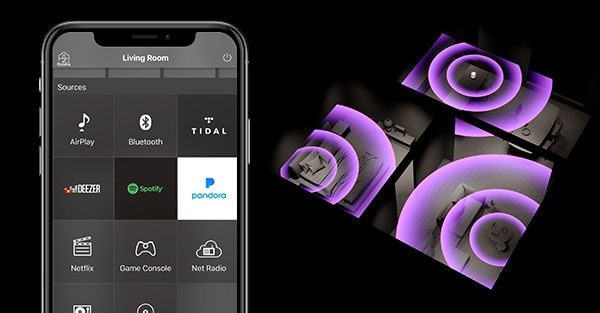
Another feature we get is voice control. Yamaha made sure to add support for both Amazon Alexa and Google Assistant but obviously if you want to use these you will need to have an external device like an Echo Dot or Google Home device. You also have the ability to use Apple’s Siri voice control through the Airplay 2 app in your mobile device.
And since we mentioned Airplay 2 we should talk about the streaming and multi-room capabilities of this unit. MusicCast is supported and with it you can connect various MusicCast enabled devices to the receiver. This can be done through the MusicCast mobile app that is available for both Android and iOS devices. If on the other hand you are more of an Apple guy the included Airplay 2 app will do for you and let you connect various Airplay 2 devices to the unit. The Airplay 2 app is available in the Apple store for you to download.
The receiver also comes with some multi-room capabilities which are slightly enhanced from what we got in the RX-V4A. The surround back or front presence terminals can be wired with speakers on another room in order to create a Zone 2. With the RX-V6A, if you want to place speakers in another room, you have the ability to go for either a 7.2 channels + Zone 2 or a 5.2.2 channels + Zone 2 speakers configuration.
But MusicCast and Airplay 2 are not only capable at creating a multi-room environment but can be used to stream music online through various streaming services. Many of the most known names are available like Amazon Music, Spotify, Pandora, Napster, SiriusXM, Tidal, Deezer and Qobuz to name a few.
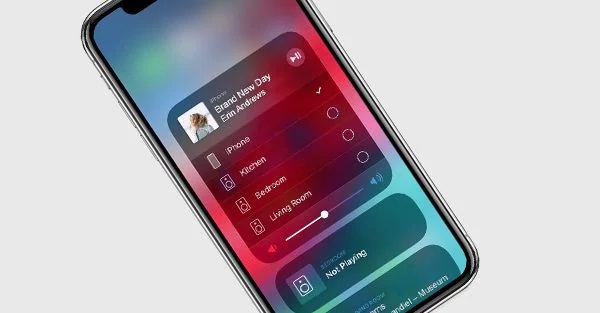
But streaming is not restricted only to it’s online services as you can also use the receiver to stream audio from a NAS server or network drive you have connected to your local network. We already mentioned above about it’s USB streaming capabilities so the last thing we need to mention is its Bluetooth support. The unit comes with Bluetooth v4.2 and it can be used to stream music to a Bluetooth enabled speaker or headphones.
But the RX-V6A has more features under its belt that should be mentioned. One is HDMI to HDMI up-scaling to 4K resolution if you prefer this to be done by the receiver instead of your TV. Now if you should use this or not depends on how capable your TV is, so it is our suggestion you try both ways in order to determine which one is better. There is also HDMI-CEC with which you can use the TV’s remote to control the receiver and thus lower the number of remotes you have to use in your home theater.
Bi-amp capability is also supported if you want to drive the high and low ranges of the front channels by using independent amplifiers which can improve the acoustic result and performance of the front soundstage. And while this is a more advanced feature that doesn’t have much value in such an AV receiver it’s always good to have it as an extra feature and one that many home cinema fans do appreciate.
Lastly there is support for wireless speakers including the MusicCast 20 and MusicCast 50 surround speakers. Also there is the MusicCast SUB 100 subwoofer that you can connect to the unit. This way you are not bound by wires and you can place the speakers whenever you want in your area.
The RX-V6A offers more or less the same features as the RX-V4A. There are some slight improvements as we get a better YPAO system and better multi-zone capabilities but other than that Yamaha offers a pretty standard feature list to this mid-level AV receiver which is more than enough for most users.

Final Thoughts
The RX-V6A is another stellar release from Yamaha that tried their best to offer us something fresh with their new 2020 lineup. In terms of specs the unit cannot be classified as a direct replacement of the RX-V685 as there are more than enough differences between them to be compared to each other.
The 2020 RX-V6A is defined by two things. It’s new fresh exterior design and the inclusion of three HDMI 2.1 ports with Yamaha being the only one in 2020 to offer more than one. Everything else was the usual that we are accustomed by Yamaha. Performance was more than stellar, feature wise the unit brings everything you will need to the table for its price both in terms of online streaming but also with its offline capabilities. Some features like Dolby Atmos Height Virtualization along with a few of the new HDMI 2.1 features needs a firmware update to be enabled but at least the receiver gets them even if not during initial release.
The most obvious downside is the HDMI 2.1 limitations but this applies to all 2020 AV receivers with HDMI 2.1 ports. And while this problem seems to focus mostly on the Xbox Series X at the moment the more common the new port will become and more 4K@120Hz signals will become available this problem may become more evident with these 2020 models. Also the unit has less legacy ports this year compared to previous years and lastly the remote feels cheap and certainly not on par with the new modern design we got.
The Yamaha RX-V6A is an excellent mid-range AV receiver and comes with everything one would need for a moderate home theater system. If you are not a gamer the HDMI 2.1 problems will not affect you at all and even if you are the problem is very specific and may not appear in your specific setup. But other than that, Yamaha released another great mid-range AV receiver to go with their refreshed lineup. Highly recommended.
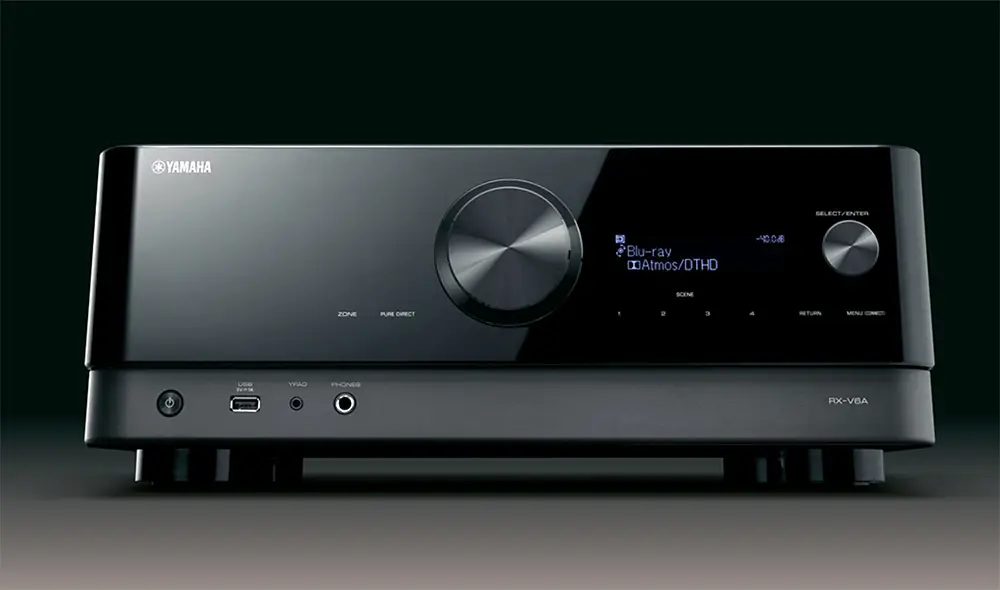
For more reviews you can check our dedicated 7 channels 8K AV Receiver reviews list or even look at our Product Reviews Table where you can find the brand and specific product you are looking for.
Cheapest Places to Buy :
*We are a reader-supported website. When you buy through links on our site, we may earn a small affiliate commission at no extra cost to you. Home Media Entertainment does not accept money for reviews.*
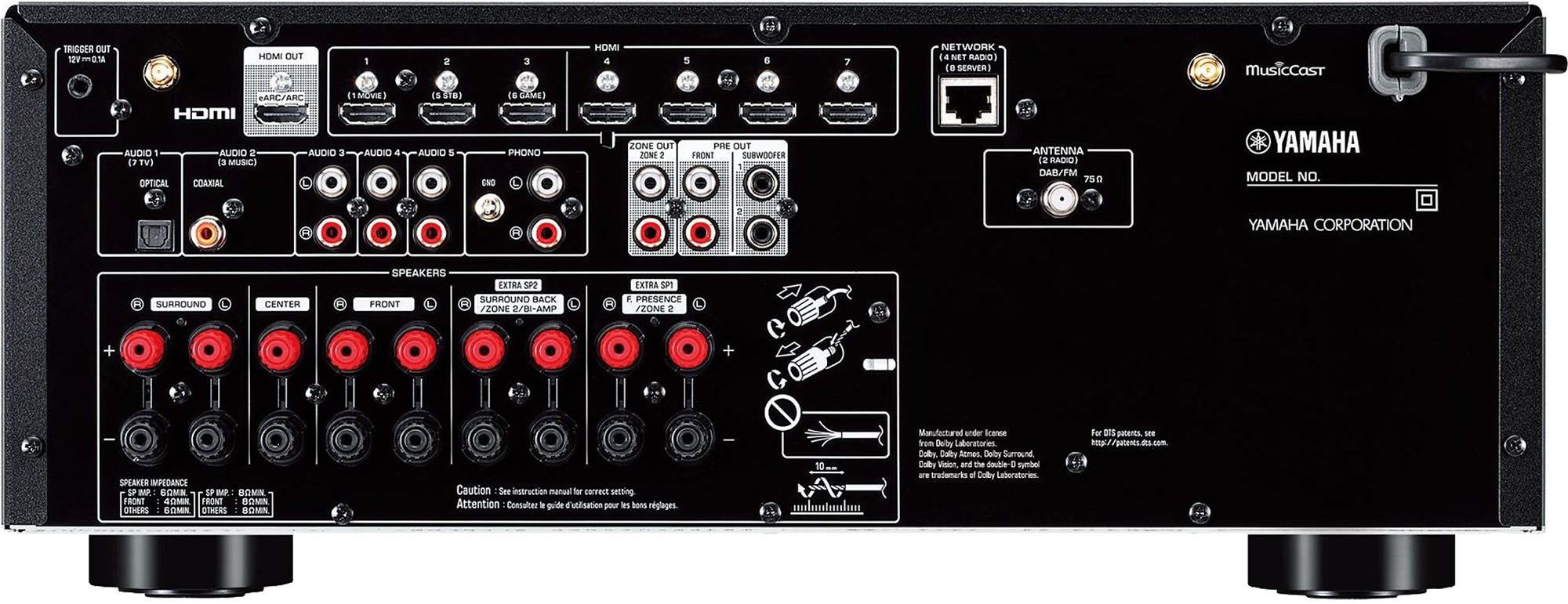
Thank you for this awesome review, Yamaha has truly been a reliable name since I can remember, I used to play piano as a kid and my first piano was a Yamaha given to me as a gift on my 10th Birthday.
Finally a refreshed design, Yamaha really needed one after so many years. The RX-V6A looks nice but I will probably wait to see the rest of the Aventage series before deciding. Currently they have only the RX-A2A released. I wonder when we will see the rest.
It seems that Yamaha decided to split the releases of the redesigned models. Hopefully in 2021 the rest of the Aventage will follow.
Hi.Thanks for this review.Is this model suitable for my 45m2 living room ? Or should i may considerer other options?
Thank you
Felix
Hello Felix. Your question a bit vague. I will need more information in order to give you a more honest answer.
Is this for a home theater setup or music? Is all the area dedicated to your setup or includes other space also? How many channels are you going to use? Is this a living room type of room or dedicated home theater space? What kind of speakers are you going to use with the Yamaha?
Hello there! This is a very detailed review you did there on the RX-V6A. I like that Yamaha offers more HDMI 2.1 ports than all others but they have the same problems as the rest. I will probably wait for the 2021 models and hopefully they will have fixed this.
Hey Mike. The problem is universal as they all use the same HDMI chipset. But if you are not playing on a Xbox Series X you are not going to have a problem as the PS5 is working perfectly with the current receivers.
Tenho um resumindo. É uma confirmação de boa qualidade tou muito satisfeito com tudo ótimo recomendo vivamente. Mas tenho dúvida que gostaria de saber posso ligar dois subwoferes? Agradeço resposta urgente obrigado pela atenção dispensada.
Continuando está Ligado com um sub da Svs e 4 colunas gostava de ligar mais um sub da Yamaha O ns 300 se der como fica 0 som? Bom ou mau ? Solicito ajuda muito obrigado
Please next time write in English in order for everyone to understand. The RX-V6A has two subwoofer outputs at the back where it says PRE-OUT. It’s so simple. As for your second message I’m not sure I understand what you ask. You want to connect two different subwoofers? If that is so I would suggest against it. When it comes to dual sub setups it’s always the best to use exactly the same subwoofers.
Can you give us more about the other cooling solutions you mention in the article apart from using Eco.
Hello there. The best cooling solution that I recommend is by far the Aircom series by AC Infinity. In the link below is the T8 which uses rear exhaust. There are also models for front and top exhaust depending your setup.
AC Infinity Aircom T8
I am using the T8 for some time now and I could not be happier with it.
Hi Stratos,
Do you know if the issues with the HDMI limitations have been resolved in the 2022 models of the rx-v6a?
Also what is your opinion about rx-v6a compare to denon x1700h in audio quality (music stage, clarity, warmness etc), driving sprakers like polk audio s50 for example, and reability?
Thank you
Hello Stelio.
As far as your first question it depends on the manufacturing date of the model. There is a simple guide in the link below that can show if your unit is one of the older ones with the HDMI 2.1 bug or not. Unfortunately you cannot know this until you actually get it and check its firmware. At least Yamaha offers a HDMI replacement board if your unit is one of the older ones.
https://europe.yamaha.com/en/news_events/2020/2020_avr-hdmi-caution.html
As far as your second question. Both AV receivers are very close to each other. The Yamaha has a bit more power which may or may not make a big difference to you while the X1700H does not have the HDMI 2.1 bug that the Yamaha has. They do have slightly different sound but which is the best only your ears can tell you that. Because I may like different things in the sound output than you do. So as I wrote you in the email better find some retailer that have them connected so you can listen to them live and decide. But don’t expect to find huge differences between them and both are great receivers, at least in my opinion.
Ok Stratos thank you.
No problem. Let me know if you need anything else.
Great review, please tell us which speakers you have used for the test
We have used different speaker brands in our reviews over the years and I don’t remember exactly which ones we used in this one. But for many of our tests we have a full DALI Oberon setup.